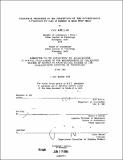Cognitive processes in the perception of the environment : a framework for study of legibility in small urban spaces
Author(s)
Khullar, Anil
DownloadFull printable version (15.56Mb)
Alternative title
Framework for study of legibility in small urban spaces
Other Contributors
Massachusetts Institute of Technology. Dept. of Architecture.
Advisor
Sandra C. Howell.
Terms of use
Metadata
Show full item recordAbstract
This study is on development of a method for investigating the relationship between the legibility in the urban environment and various components of the visual environment, as perceived. and remembered by the people. The focus of the study are small urban spaces in Boston. The study developed a series of experimental protocols to study the response of the people to the various squares, around Boston. The emphasis of the study being to explore the possible approaches to collecting information related to perception of the urban environment. The phenomena of perception relating to small urban spaces. was discussed within the framework of theories in cognitive psychology. The study proposes that people are able to discriminate and distinguish squares based on the salient qualities. but are unable to distinguish between the various expectant elements such as window types. street lights and benches. The absence of salient qualities in small spaces, make them illegible. The role of schema, in developing a very vivid image of a place. was an important basis for proposing the existence of saliency and expectancy as dimensions of legibility. The domain of the research is restricted to issues relating to various ways in which information relating to the visual quantity of the environment could be extracted from the people using the techniques often used by psychologists. Some of the findings from this research indicate. that each technique used in study, gave different type of information relating to the physical features of the squares. The thesis finally argues for the development of a standard methodology to identify. and establish salient and expectant features about a place. and cities within a cultural context. The coherent vocabulary of design elements that would develop through this, would enhance the chances of a better fit, between the users of the space, and the professionals.
Description
Thesis (M.S.)--Massachusetts Institute of Technology, Dept. of Architecture, 1985. MICROFICHE COPY AVAILABLE IN ARCHIVES AND ROTCH. Includes bibliographical references (leaves 91-93).
Date issued
1985Department
Massachusetts Institute of Technology. Department of ArchitecturePublisher
Massachusetts Institute of Technology
Keywords
Architecture.